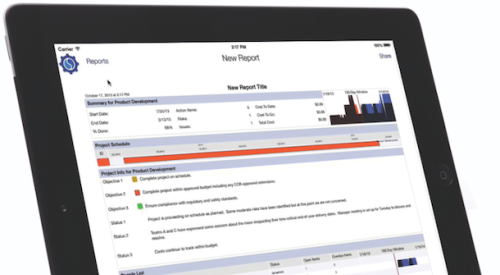Photo: As demand for new-home construction began to wane, Steve Laughlin of Cornerstone Builders tapped into his past clients by offering home inspection and maintenance services (see moneymaking idea #11).
Sure, the past five years have been chaotic and the prospects for 2011 don’t exactly look entirely sunny. But there are plenty of builders and developers that are planning for growth this year by doing anything but the status quo — breaking into new markets, expanding services, increasing operational efficiencies, reworking their products, and the list goes on.
We reached out to Professional Builder’s 112,000 readers, as well as dozens of the industry’s top consultants and experts, and asked them to share their best practical, proven ideas for growing revenue and increasing profits in 2011. We present the top 35.
1. Create a private equity fund
It can be similar to Lennar’s Rialto and Toll Brothers’ Gibraltar Capital, but on a much smaller scale to acquire and renovate investment properties in your local market. Deals can range from a couple of single-family homes bought at auction to a small retail center or apartment building. The closer you stay to the expertise of your staff, the better. Hold an invitation-only event for high-wealth individuals you know and deliver a presentation on what you have in mind.
2. Build rental storage units
If you have land that can be zoned commercial, consider putting rental storage units on it. “These things are just cash cows,” says Chuck Shinn, president of Littleton, Colo.-based Shinn Consulting, “especially with all the foreclosures. People are trying to find places to put their things. It just takes a little piece of commercial property — some oddball size that doesn’t fit anything. Every builder ought to have one because they’re so easy to deal with.”
3. Know the worker’s compensation factor for all trades
Find out the state worker’s compensation factor for every trade that works on your sites on a three-year rolling average. The safest trades are your highest-quality, most-efficient trades. Calculate this number every year and track by trade and by company. Reinforce the low-scoring trades (low is good) and help those who exceed the state norms. Set a goal of having a total trade average as less than 0.9.
4. Add value to land you own and resell it
Like many builders, Danville, Calif.-based Trumark Homes has snapped up land at bargain prices. The builder always plans to build houses on the land, but in some cases, they are seeing an opportunity to re-entitle the land for a different use and selling it. In one case, they got the property rezoned from single family to apartment use. “The value was much higher as apartments,” says Trumark partner and general counsel Jason Kliewer. “We sold the property to an apartment REIT and made a pretty good profit.”
5. Expand into property management
Operating in one of the hardest-hit housing markets in the Midwest, Mark Teitelbaum of St. Louis-area Seabrook Homes knew his company had to diversify to survive the downturn. So one day in late 2009, he called a friend who ran a commercial property management company in the area.
“As it turned out, he said he was a bit overwhelmed with the accounting and property management of his accounts,” says Teitelbaum. “We agreed to form a partnership to take care of the reporting, repairs, and maintenance, and bidding contracts for stuff like maintenance and snow removal services.”
Having worked on several commercial and industrial properties in the past, Teitelbaum felt his company understood commercial buildings. The challenge was learning the accounting and reporting required for the management of commercial properties. “There’s definitely a learning curve,” he says. “You have to understand your client’s needs from an accounting standpoint. You have to know how to execute balance sheets, income profit statements, capital improvement programs for the continual maintenance of the property, etc. Luckily, we have a great accounting staff.”
In July, the builder took over full management of three commercial shopping centers and a condominium project. The company earns 4-5 percent of total income collected and has the potential to bid on tenant fit-outs, at a 10-15 percent finish fee. “It hasn’t solved all of our cash-flow issues, but it’s definitely helped,” says Teitelbaum.
He says builders with a strong accounting department and commercial construction expertise have an inherent advantage over traditional property management firms. “They’re just collecting receipts and doing accounting,” says Teitelbaum. “As a builder, we can respond to a repair call and determine on the spot, for instance, that if it’s a leak, it’s a leak from the HVAC system or the roof membrane itself. We can patch it immediately and also work on a long-term solution.”
6. Sell luxury upgrades as an affordable daily amount
Since too many choices can sometimes confuse customers, present bundles of luxury choices at varying investment amounts. Then present the bundles as a daily figure. For example, a $10,000 luxury kitchen bundle could be presented for less than two dollars a day — less than a slice of pizza!
7. Process map your organization
Do you understand where you have redundancies and inefficiencies? Is everything you’re doing directed at your core purpose? Process mapping is especially beneficial today, as most builders have downsized significantly and have employees wearing multiple hats. It’s about making the most of the people you have.
8. Rent out your speculative homes
Can’t move those spec homes? Consider renting them. Cornelius, N.C.-based builder Nicole Goolsby, president of Rion Homes, has tenants in four of her houses. All of the tenants wanted to buy, but couldn’t qualify for a loan at the time. To be sure, Goolsby would rather sell a house than rent it, but rental income is better than spending money out of her own pocket every month to pay the banks, and having a tenant in a house is a deterrent to theft and vandalism.
9. Conduct weekly field audits
If you’re not regularly checking, logging, and reporting on what is being delivered to your sites, chances are you’re spending too much because of inaccuracies and waste. Start with one check per week per site of lumber and trim delivery counts, concrete temperature and slump rate, roofing material counts, brick and block, and anything else you suspect might be an issue. And make sure the drivers see you doing it. Pretty soon you can fall back to monthly checks.
10. Start a home buyers club
Instead of discarding customers who can’ t get a loan approval today, introduce them to a reputable credit repair specialist and hold their hand while they rebuild their credit. When their credit is fixed convert them into quick sales.
11. Offer home maintenance and inspection services
During the course of past 31 years as a custom builder in the Wichita, Kan., area, Steve Laughlin of Cornerstone Builders has built a clientele list 150 deep. As demand for new-home construction began to wane, Laughlin decided it was time to tap into his past clients by offering home inspection and maintenance services.
“In the past, we were so busy we didn’t have time go back to our past customers,” says Laughlin. “Offering these services has certainly helped to fill in the gaps between new construction jobs.”
The company offers everything from major HVAC, roofing, and siding repair jobs to basic walkthrough inspections with the owner. “We’ll check caulking around windows and the exterior, look at the interior tile work, and discuss what their basic maintenance needs should be,” says Laughlin.
While home maintenance is not exactly a lucrative venture — Laughlin typically charges $40 an hour, plus material, and a 10 percent fee for any construction or repair work — it occasionally leads to larger jobs, such as bathroom and kitchen remodels.
“Just taking the time to talk with them and ask about their needs opens up much more opportunity,” he says. “I would say three out of four calls we make turn into some type of home inspection or maintenance work, and about 10 percent of those result in a remodeling job.”
12. Measure and identify your cost of non-conformance
Whether it’s waste, rework, cost of inspection, or warranty, chances are non-conformance is costing your business. Identify your top-dollar impact and use quality tools and techniques to attack these issues that are reducing your profit.
13. Do commercial tenant finish work
Chuck Shinn, president of Shinn Consulting, Littleton, Colo., says he did this kind of work as a builder during the last downturn. “Find out who the owners are, work with them, get a lead on who’s moving in, maybe do a little space plan for them — it’s pretty simple. It’s metal studs and drywall. You need an electrician, a drywall installer, and maybe a plumber.”
14. Conduct a monthly plan review
Have a set schedule and time each month when you cycle through your most popular plans. Hold two 90-minute meetings, back-to-back, with front-end trades and back-end trades. Challenge each trade to bring at least five ideas to reduce cost, increase value, ease construction, or improve the process. Savings will accrue from each meeting.
15. Become a government consultant
Jeff Burton, president of SAF-American and American Dream Development in Junction City, Kansas, has always had a heart for the military. A veteran himself, he had developed a successful niche in building affordable housing for soldiers near military bases. “We’re still building, slightly,” Burton says. “Fortunately, about a year before the big recession, we started doing some consulting specific to military communities.”
From that, his company shifted gears and is doing housing and hospitality training and business development for government and quasi-government agencies. “We’ve been awarded to do an international contract for all of the Army’s housing and barracks management and housing referrals,” Burton says. “We’re slated to do training in Europe, Korea, and domestically. It’s pretty cool.”
The company also is working with NISH, a national nonprofit agency that works to create job opportunities for people with significant disabilities by securing federal contracts for community-based nonprofits.
“We’ve been tasked to assess their organization for hospitality services, marketing, brand management, and the concept of delivery in the housing-related fields,” says Burton. “We’ll train their providers. They do all their work through community rehabilitation programs. We’re helping align that network.”
For anyone interested in pursuing government contracts, Burton says “the bar for participation is pretty high. There are a lot of competitors.” Plus, the government wants three past performance references of similar scope and scale to bid on contracts. Burton says they’ve become experts at teaming with other companies and organizations, such as Kansas State University, Aramark, and the NAHB Research Center, to qualify for the jobs. “It’s similar to joint venturing without the legal entities,” he says.
To do government contracting in the building industry, Burton says, “you pretty much have to align with an architectural design firm. Most government stuff is design-build. Plus, you have to bond the entire process.”
To learn more about government contracts, Burton suggests visiting www.fedbizopps.gov, where all opportunities are posted.
16. Create site-specific plans
Provide fully-detailed, site-specific plans for each and every house, from bidding through construction. Don’t leave it up to your suppliers and trades to decide what goes into each house and how it is constructed. Once you’re set up to do it, the cost is minimal compared to the continual errors, mistakes, and rework, as well as the communication and paperwork required to deal with these.
17. Get into the medical office construction business
Have your sales team call on every medical practice in your area with a presentation on the merits of owning versus renting their office space. Many private practices have moved to office condo parks where the product is not much different than single-family housing.
18. Get world-class consulting on the cheap
Anytime you hear of a top-shelf employee being laid off from a competitor, immediately invite him or her to lunch as a means to help them network and to build a relationship. Great people tend to know other great people, so you never know where it will pay off in the future. If you can’t afford to hire person, consider bringing them onboard for a week as a consultant for special projects or to help tweak your current programs. It’s a short-term win-win.
19. Know your competitors inside-out
From visits to competitive communities and home sales data, determine what is selling well and what is not. Capitalize on what buyers value most by offering it better than your competition does.
20. Rehab and resell foreclosures
Ron Froehlich, president of Froehlich Signature Homes in Bakersfield, Calif., has been buying foreclosures from banks, fixing them up, and reselling them. Some just need carpet and paint, others have been trashed and stripped out, and need to be completely redone. Start with the price that the house would get in a fixed-up condition and work back from that to get the purchase price. “It’s one of those deals where the numbers don’t lie,” Froehlich says. List the houses with a real estate agent who specializes in affordable homes. Include enough cushion in the price to pay closing costs and offer the houses with a one-year home buyer’s warranty.
21. Shop on total cost, not initial price
Develop your criteria for total cost and use them to select suppliers and trades, never initial price. Buying on initial price alone guarantees that you will miss the full value in product and services more than 90 percent of the time.
22. Rebuild fire-damaged homes
Nicole Goolsby, president Rion Homes in Cornelius, N.C., has managed to survive by “being willing to take on projects that you haven’t done before.” She started rebuilding fire-damaged homes after one of her trade partners lost her home to a fire and asked Goolsby to rebuild it. Then someone else in her HBA knew someone who had a basement fire and referred Goolsby for the job. She’d done plenty of renovation work on houses, but had never done insurance work or a complete rebuilding of a house.
It’s not work she would have chosen, but she was willing to do the work because she cared about the people who asked her, and she knew she could make a difference.
“They’re not pleasant,” she says of the jobs. “They’re stinky. I just got off the phone with an attorney because they’re having so many problems dealing with the insurance adjuster. But it’s a little more rewarding than upgrading someone’s $60,000 kitchen. It suits me.”
The key to making the work profitable, she says, is having an in-house laborer do the work. “It would be difficult to subcontract everything because you don’t have the tight reins on the schedule that’s necessary,” she says. “Renovation work is a whole different kind of scheduling, and insurance work is one step beyond that. The money takes longer to approve, and you don’t get compensation for the stress and duress.”
It’s been an advantage, she says, that she decided early in her career to get the Certified Renovator designation from NAHB. “Two of the homes I’ve worked on have been built prior to 1976,” she says.
For now, Goolsby says she’s getting by without marketing her services to the insurance companies. “I thought about it, but it’s not something I really want to do. I work for the clients, not for the insurance company.”
23. Adapt your plans for new buyers
Irvine, Calif.-based MBK Homes has marketed several of its communities to Asian buyers “with overall good success,” says Rick Fletcher, vice president of sales and marketing. MBK tweaked one of its plans to include a “dramatic, high-volume entry ceiling, which is very popular with Chinese buyers. We have also started offering high-powered kitchen range exhaust fans to better suit the cooking styles of Asian buyers. We have all of our house and community plans evaluated by a Feng Shui expert.”
For new product MBK is developing now, the builder is looking at providing a space at the entry foyer of the home to store shoes prior to entering the home. Marketing is done through advertising in the Chinese Daily News and the United Times Southern California newspapers, as well as in various Chinese new-year calendars and publications. The builder also sponsors a booth at the annual Asian Real Estate Agents convention and employs sales reps who are fluent in Mandarin and Tagalog.
24. Implement even-flow production
Batch-releases of housing units drives tremendous hidden costs internally, and even more so for suppliers and trade contractors — far beyond what almost any builder appreciates. They are forced to work as if they are much larger than they are, then have no work. Use the identical schedule for every product you build and make it totally predictable. You will get the best trades with the best crews and for the lowest prices.
25. Inspect, rehab, and manage distressed assets
When banks take back residential and commercial properties, they need a thorough assessment of the condition. Those properties need to be brought to a ready-to-sell condition. They need to be maintained and they need to be sold. Rincon Real Estate Group, which is run by three former K. Hovnanian employees, offers all four of these services to banks. “No one takes all four of those — we tailor it to the client,” says Tom St. Clair, a partner in the Encinitas, Calif.-based group. “That’s been fairly successful.”
The hardest part of the work is getting the business, says St. Clair. “With any new client, there’s a three-month window of testing,” he says. “Once you pass that hurdle, the floodgates open. You become a preferred vendor and they send you everything.”
Rincon now has four bank clients, and the volume of work has been enough that they had to bring on a fourth person.
26. Help potential buyers sell their home
Bill Saint and his team at Classica Homes meet plenty of people who are interested in buying into one of the builder’s Charlotte, N.C.-area communities, yet they can’t make a move until they sell their current home. Classica helps potential buyers overcome this problem by offering free design and home staging consultation, as well as repair and construction services at a discounted rate.
Saint says he’s employed this tactic “quite successfully for several years,” and it’s a perfect fit for just about any home builder. “It matches up the strengths and talent that you probably already have on your team to what the buyers need,” he says. “You have great construction talent, and they probably need something fixed up on their house. You have design talent, and you’re probably the best at spiffing up interiors into a show home.”
The builder also helps buyers market their homes by developing a CMA study to identify the top Realtors in their area and assisting with the logistics of placing the home on the market.
27. Challenge your architect to contain costs
The vast majority of architects have little practical concern for cost. Redefine their mission as a partner to create value by providing beautiful, functional plans, and elevations at the lowest possible cost in any price range. If your architect doesn’t get the idea — find one who does.
28. Serve as a homeowner’s advocate on remodeling projects
Seal Beach, Calif., builder Steve Peters was channel surfing one night and happened on “Holmes on Homes,” an HGTV show about a crusading contractor who repairs the shoddy work done by unscrupulous remodelers who refuse to fix their mistakes. “I saw how he was bashing general contractors and made us sound like babbling idiots,” Peters says. “Then I went to bid a custom job and the first thing the guy said was, ‘I watch Holmes on Homes.’”
From that, Peters has started a business as a homeowner’s advocate — essentially a project manager — to oversee the work that’s being done in their home and make sure they’re not being ripped off. “They don’t have any knowledge of construction,” he says. “They’re at the mercy of the GC. My real hope is to show them there are some good guys out there.”
He’s marketing the work the old-fashioned way — with a tri-fold brochure he’s delivering door to door in his target area.
29. Conduct all-trade reviews at the model stage
Walk through the model with each supplier and trade individually at a stage where their work is fully visible, challenging every piece of the product and process for appropriateness, efficiency, and waste. Hold additional walks with multiple trades to resolve issues of trade conflict or trade-off benefits that are discovered.
30. Adopt web-based scheduling
Do it, but only if you’re committed to keeping it updated on a daily basis. Even the trades that balk will come to love it when they find that anytime, anywhere, they can access the schedule and see exactly where they need to be, in advance. The time savings in phone calls alone will free up field personnel dramatically.
31. Perform your own quantity takeoffs
Always do your own takeoffs for the major elements of each house, then compare yours to the bids received. After picking the supplier or trade based on total cost, sit down with them and walk through both takeoffs (theirs and yours) together. Challenge each other. Things always get better.
32. Keep past customers informed of your community happenings
By staying connected with past clients in a genuine way, builders have been able to parlay their existing customer satisfaction base with a referral sales strategy to reap a referral sales rate of 40 percent or more. Referral sales strategies include planting the seed for referral sales, providing an incentive, and staying connected to all potential referrers.
33. Challenge your engineer to minimize cost
The vast majority of engineers view their job as to “seal the plan” to gain approval from local authorities. Redefine their job as a partner to help your team meet all codes and gain approval at the lowest possible cost. This may cost you a bit more up front, but your ROI will exceed 1,000 percent in short order.
34. Involve key suppliers and trades in the design process
At a minimum, involve key suppliers and trades at black-line stage to help eliminate “design-induced” costs in the beginning. The savings accrue quickly to the builder, suppliers, and trades alike. Review again before prints go to field for model build, and make necessary adjustments.
35. Offer aging-in-place solutions
After Kimmi Houston’s elderly mother had a heart attack, Houston built her a patio home a few blocks from her own house. “That was my first experience with integrating the aging-in-place ideas,” says Houston, who is president of Houston Homes in Edmond, Okla. “Her house was a learning tool.”
After her mother passed away, she converted the house to a rental property. “All I had to do to make it not look handicapped was take out a couple of bars in the bathroom. Everything else was inconspicuous. After that, I started advertising my houses to baby boomers caring for their parents. All my custom homes incorporated some element of it.”
With the downturn, Houston obtained her Certified Aging in Place Specialist (CAPS) designation from NAHB and now focuses on remodeling existing homes for aging in place.
Many times, homeowners aren’t even thinking about accessibility — they just want to remodel their kitchen or their bathroom.
“A lot of times, you see this epiphany,” she says. “They never thought about it. They realize that if they’re going to invest the money and stay in the house, they need to make it a little more efficient and accessible. And they’ll get something they like and upgrade it with some nice new features. I think it’s a win-win for everyone.”
Marketing for the service is decidedly low-key. Houston has a “lot of repeat and referral business. The word gets out.” Plus, she sends out a newsletter to her previous customers about three times a year with news and tips. “Invariably, I get emails back, asking questions, and I get referrals from that.”













